Rifle Ljutic Space Gun (USA)
It should be noted that the biography of Al Lewtik (1913-2007) is no less interesting than the developed models of sports weapons. In the thirties, the future American gunsmith of Croatian descent, by this time already having some experience in the field of design and mechanics, became a professional heavyweight boxer. Soon he left boxing and became interested in shotgun shooting. Becoming a gunner, the future gunsmith used ready-made serial samples of guns and at the same time showed very remarkable results. For several years he managed to become one of the best shooters in the United States.
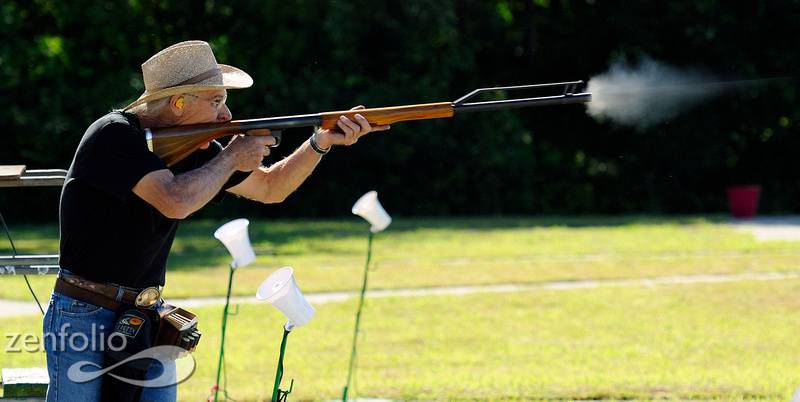
Shot of Doges Space Gun. Photo Trapshooters.com
At the end of the forties, E. Lütik was admitted to the US Olympic team in bench shooting. The shooter's debut at the Olympics was to be held in 1940, in Tokyo. However, a few years before their start, these games were moved to Helsinki. Finally, after the start of the Second World War, the competition was finally canceled. Designer shooter could not get to the Olympic Games and compete with the best athletes in the world. However, such a failure did not make E. Lütik abandon his passions.
According to some information, doing bench shooting, the future designer gunsmith independently refined and improved his weapon. In one way or another, he enhanced various characteristics and achieved a certain superiority over serial samples. However, further updating the existing guns did not make sense. To gain radical advantages, a completely new weapon had to be developed. In the early fifties, E. Ljoutik developed a new version of mechanics, subsequently brought to serial production under the name Winchester Model 100.
In 1955, friends called the designer at the shooting range, but it turned out that he did not have the appropriate weapons. He took advantage of this opportunity, and literally in a day he developed and built in his own workshop the first gun of a new type. In this improvised project, some original ideas were used that made it possible to increase the accuracy of the fire. Subsequently, based on the basic design - without significant changes to it - a project was launched, launched in a series.
The serial weapon was distinguished by its specific appearance, and therefore it bore the appropriate name - Ljutic Space Gun ("Ljutik Space Gun"). Indeed, samples with a similar exterior at that time could be found only in science fiction, in the tentacles of aliens or in the hands of future space soldiers. The internal units of the sport rifle did not differ in their fantastic construction, but in their case important ideas were used.
The new "Space Gun" was supposed to be used at shooting ranges, where it was required to have high accuracy of fire when using the shot. At the same time there was no need in the store and related means of recharging. Such requirements were combined with existing ideas, with the result that a very remarkable weapon architecture appeared.
For maximum accuracy, E.Lutik decided to use a linear weapon layout. The barrel, receiver with a bolt and the main spring should be located in the same line. Thus, the recoil impulse had to be transmitted directly to the shooter’s shoulder, excluding tossing the barrel with interference. For greater ease of use, the gun should have developed wood fittings of ergonomic shapes.
The shotgun was notable for its simple layout using the minimum of necessary parts. About half of the total weapon length accounted for a sleek 30-inch (762 mm) barrel with interchangeable chokes. The latter were fixed on the muzzle of the barrel with the help of a thread. The barrel chamber was designed for use with standard 12 caliber cartridges. The breech of the trunk went deep enough inside the tubular receiver and was rigidly attached to it. In this joint of two parts was protected by the forearm.
Also, about half of the total length of the product accounted for a tubular receiver, which simultaneously served as the body for the mechanisms and the butt. In front of it, just behind the chamber, there was a movable shutter. Behind him was a massive drummer. The entire rear part of the tubular box, which was distinguished by a smaller diameter, was in fact the body of the return and combat spring. Behind the forearm on the bottom surface of the receiver there was a rectangular window for feeding cartridges and ejecting shells. Behind this window was a notch with several through slots leading into the box. This recess was designed to install the trigger mechanism in its own body.
Single shotgun rifle received the mechanisms of the original design. It was due to the system in the composition of the bolt, drummer and return spring, it was supposed to increase the accuracy of shooting. The correct calculation of the parameters of individual parts led to the appearance of a certain similarity to the so-called. balanced mechanics. When fired, some of the forces acting on the weapon were to suppress each other, enhancing the basic characteristics of the fire.
Ljutic Space Gun was proposed to equip the gate with the original design. The bolt group had a shutter itself, made in the form of a cup with a cylindrical side surface. The latter had slots, with the help of which the lugs were formed. Locking was done by turning the bolt with a long handle, which was brought out through the window for feeding cartridges. Behind such a shutter there was a bolt carrier with a greater length of cylindrical section with straightened surfaces. In its rear part there was a vertical cut, necessary for proper interaction with the percussion mechanism. Inside the bolt carrier there was a pusher whose task was to move the striker back while the barrel was unlocked.
Through the longitudinal channel of the bolt and its frame, a needle-shaped block passed through the front end of a large and massive cylindrical drummer. The latter was located behind the bolt and the back part rested against the reciprocating-combat spring. It is precisely the correctly calculated combination of a striker and a spring that allowed E. Lutic to obtain the desired results.
Shotgun equipped with a simple trigger. All its parts were placed in the case of a simple form, with the help of a screw fixed under the receiver. The mechanism included a trigger, designed in the form of a button. Its upper part, which remained inside the case, had a U-shaped notch to communicate with the sear. The latter was a swinging lever with a small protrusion on the bottom surface. In terms of its structure, the “Cosmic Gun” USM to a certain extent resembled devices for submachine guns of that time.
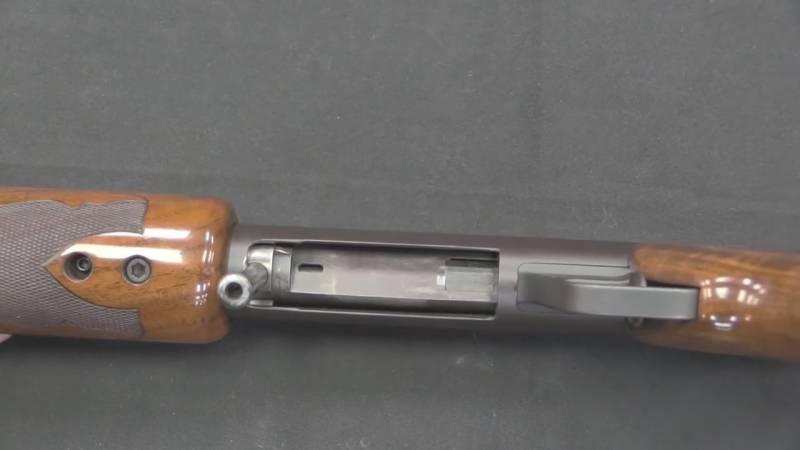
The lower part of the receiver. One can see the bolt with the bolt carrier, their handle and the front part of the drummer. Photo Forgottenweapons.com
The specifics of the bench shooting, as well as the main features of the design of the gun, influenced the structure of the sighting devices. Due to the linear layout of the weapon, the sight had to be mounted on a special frame. On the front part of the trunk, which was not covered by the forearm, a trapezoidal frame of sufficient height and relatively large length was installed. In its front part was the front sight, in the back - the rear sight. For greater ease of use, the elements of the sight had corresponding marks.
Despite the clearly handicraft nature of the project, the sporting rifle received rather complicated wooden fittings. The space from the window for cartridges to the frame of the sight was covered with a cylindrical forearm of variable section. A curved wooden handle of the "anatomical" shape was mounted on the main body. The back of the receiver was completed with a tubular wooden lining, which served as the cheek of the butt. At the end of the receiver was fixed metal shoulder rest with a rubber butt pad. E.Lutik's serial guns could have one or another notch on wooden details.
In size, the Ljutic Space Gun was a little different from the production models of its class that existed at that time. Weight - 8,5 pounds (3,86 kg), which roughly corresponded to some other guns of the time. The implementation of the most original ideas led to the fact that the new gun had non-standard operating principles, which gave a certain increase in a number of characteristics.
To prepare for the shot, it was necessary to move the shutter handle to a small angle counterclockwise (from the shooter’s side) and take it back. When this occurred, the compression of the reciprocating-fighting spring, and the massive drummer, reaching the rearmost position, was blocked by a sear. Then it was necessary to insert the cartridge into the chamber and return the bolt to the front position. Turning the bolt clockwise resulted in the coupling of the lugs to the receiver. In addition, the pusher inside the slide frame went forward, allowing you to shoot.
Pressing the trigger released the sear, which fell down and released the drummer. Under the action of a powerful spring, he went forward and carried out a shot. When the shutter was opened and moved backward, an empty cartridge case was ejected, after which the gun could be prepared for a new shot.
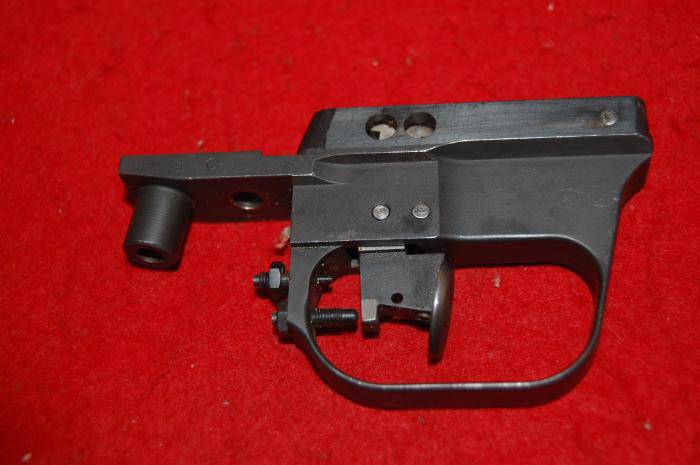
The trigger mechanism is separate from the gun, right view. Photo Guns.com
Moving to the extreme forward position and striking the bolt, the heavy drummer created an impulse directed strictly forward. Simultaneously with this, a shot took place, the return of which was going back. Two relatively powerful forces, directed in opposite directions, partially compensated each other. The strength of the impulse that goes into the shoulder of the shooter is sharply reduced. In addition, the linear layout of the weapon eliminated the tossing of the barrel. Without special technical tricks, El Luthyk managed to create a workable balanced mechanics system.
The first sample of Ljutic Space Gun was built in the designer’s own workshop. Just the day after the assembly, the prototype was tested at a shooting range and showed all its advantages. It is possible that the existing structure needed some modifications, but on the whole it met the requirements. Soon the idea to launch this weapon into mass production appeared and to offer it to riflemen-athletes.
In the same year, 1955, E. Lütik founded his own company, Ljutic Gun Company, which was to assemble the latest "Space Guns". After minor improvements of the improvised project, the shooter-designer and his colleagues began to work with the aim of earning. The serial production of such weapons continued over the next few years. Guns Ljutic Space Gun were made to order, which clearly affected the pace of production. Weapon assembly continued until the mid-sixties, and during this time only two hundred units were fired. Some sources mention the possibility of producing several thousand rifles, but similar data are refuted by other materials. All finished samples were immediately transferred to customers; such guns were not available for sale in gun shops.
The production of "Space Guns" was curtailed in the mid-sixties in connection with the emergence of new weapons of similar purpose. During this period, several prominent athletic shooters turned to E. Lewtik with the proposal to create new smooth-bore guns for bench firing. The result of the work that followed was the Ljutic Mono product. Such a gun went into a full-scale series and subsequently was modernized several times. Production of products "Mono" continues to this day.
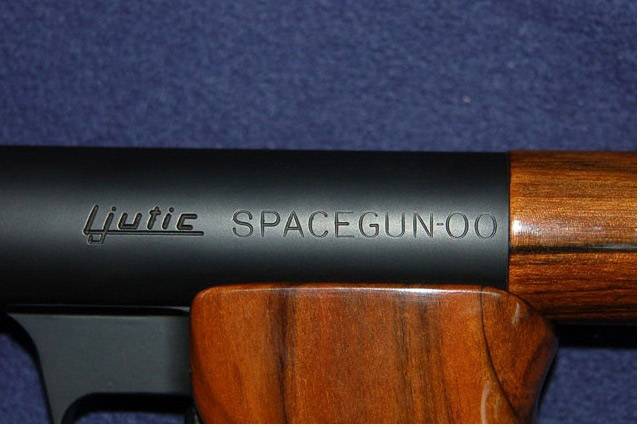
Marking on the left side of the receiver. Photo Guns.com
In the early eighties, E. Lütik’s company, transformed and renamed Ljutic Industries, attempted to return the Space Gun to the market. Based on the existing smooth-bore shotgun developed a single-shot rifle. With a total length of 44 inch (1117 mm) such a weapon was equipped with 22-inch (559 mm) barrel. Modifications for rifle cartridges .22-250, 30.30 Winchester, 308 Winchester and 30.06 were suggested. Together with an open sight rifles received the optical system.
The first production rifles of several versions were released in the 1981 year. Their production lasted for seven years. During this time, Ljutic Industries has produced no more than a few thousand rifles of all versions. Like the smooth-bore predecessor, this weapon, having a specific look and special tasks, was not particularly popular among buyers. By the end of the eighties, it was decided to abandon the "space" rifles in favor of expanding the production of guns line Mono.
The latest Ljutic Space Guns were fired about half a century ago, and the newest rifles at their base will soon celebrate their thirtieth anniversary. The production of such weapons has not started anymore and is likely to never be resumed. Now the company Ljutic Industries is engaged in the production of other sporting guns, including a number of products of a rather old family, which replaced the “space” weapon in the series.
Much of Al Luthic's guns and rifles still remain in arsenals, collections, and museums. Unique products invariably attract the attention of historians and lovers of small arms. However, not all of them can afford to buy their own gun. The Space Gun products of the fifties and sixties of release are being auctioned off at prices on the order of 2-3 thousand US dollars. Moreover, some copies had twice the value.
E. Llutik created his first "Space Gun" solely because of the desire to go to the shooting range with his comrades and take part in a friendly competition in bench shooting. Whether he managed to defeat friends with a prototype of a new weapon is unknown. However, the main results of the original project appeared already after this, in the future, when the design was improved and went into mass production. Ljutic Space Gun never released a large series, but still left an interesting mark on stories sporting weapons.
On the materials of the sites:
http://guns.com/
https://forgottenweapons.com/
http://trapshooters.com/
http://ljuticgun.com/

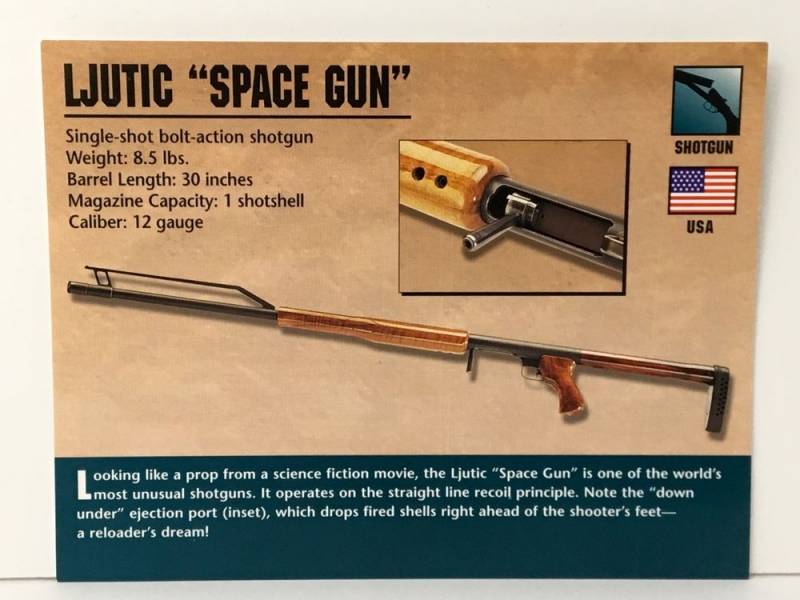
Information